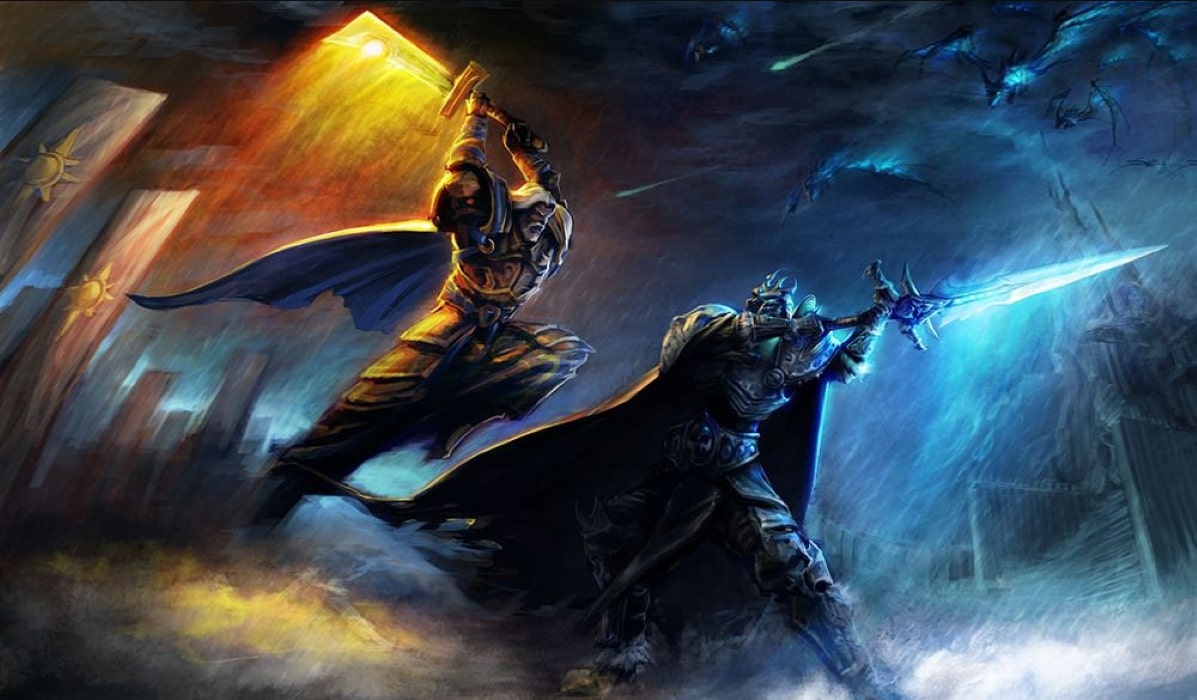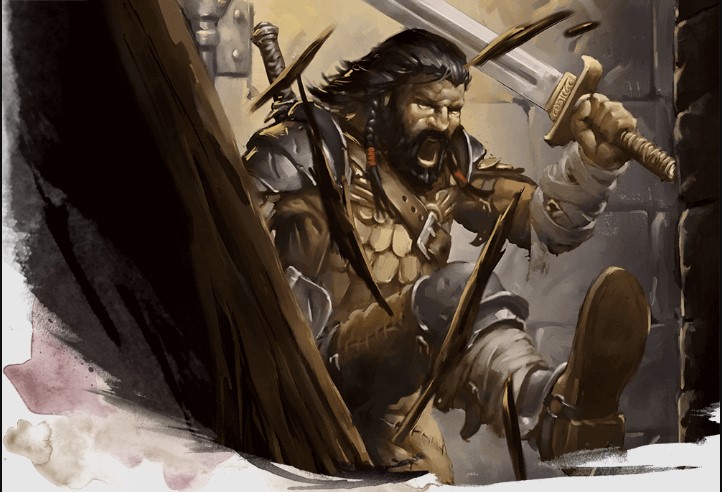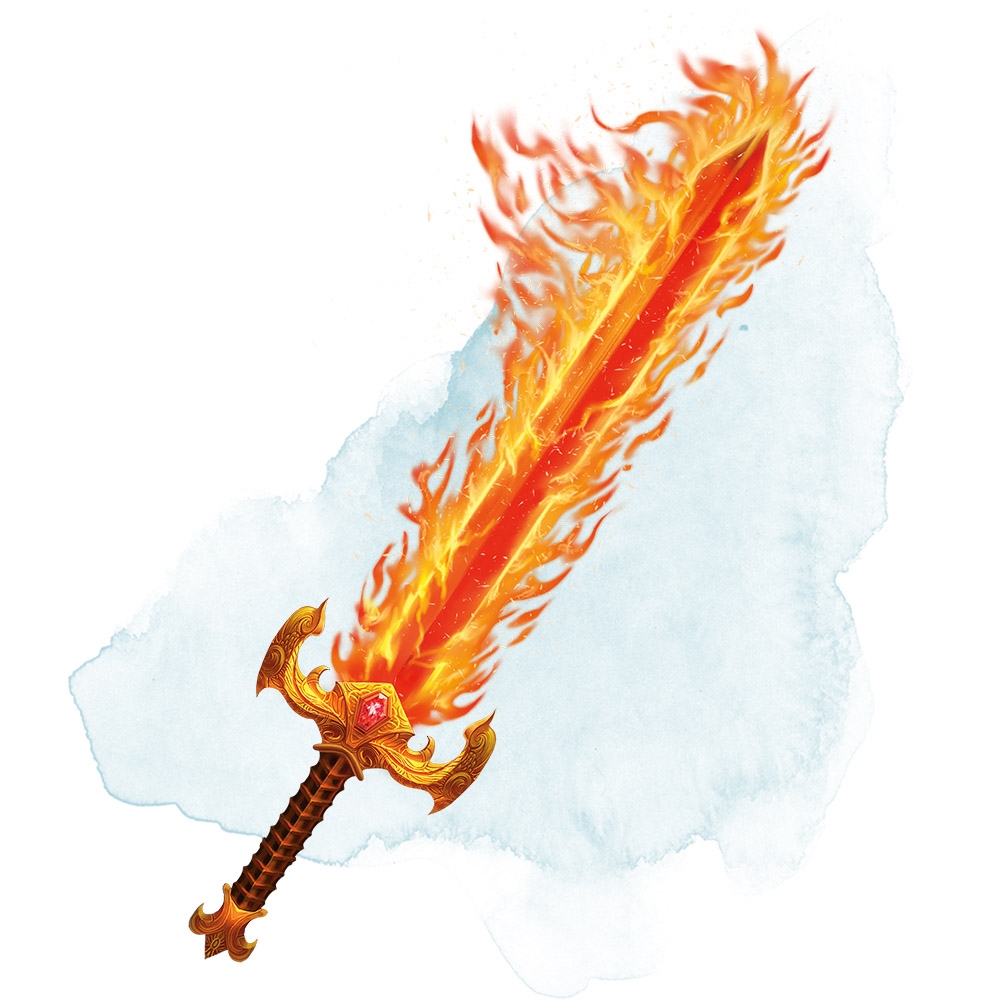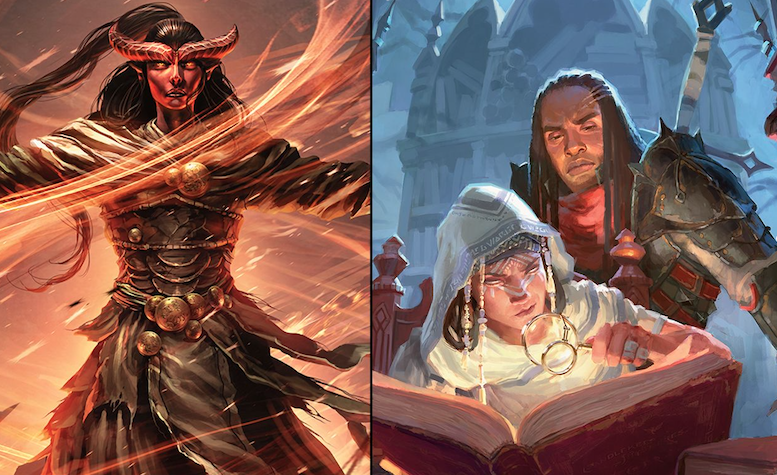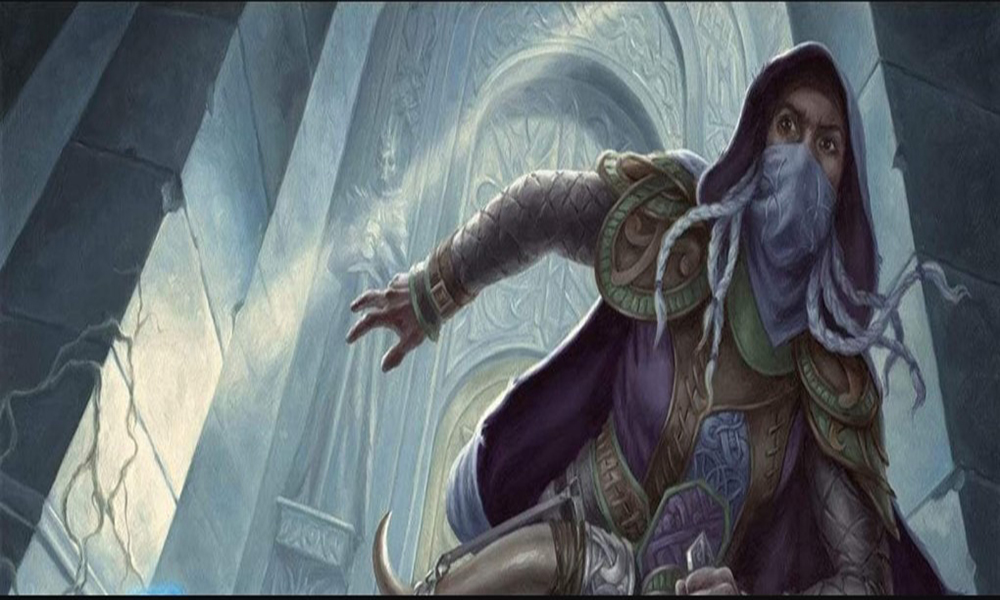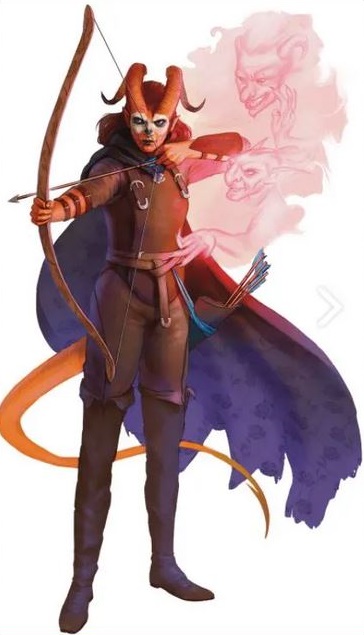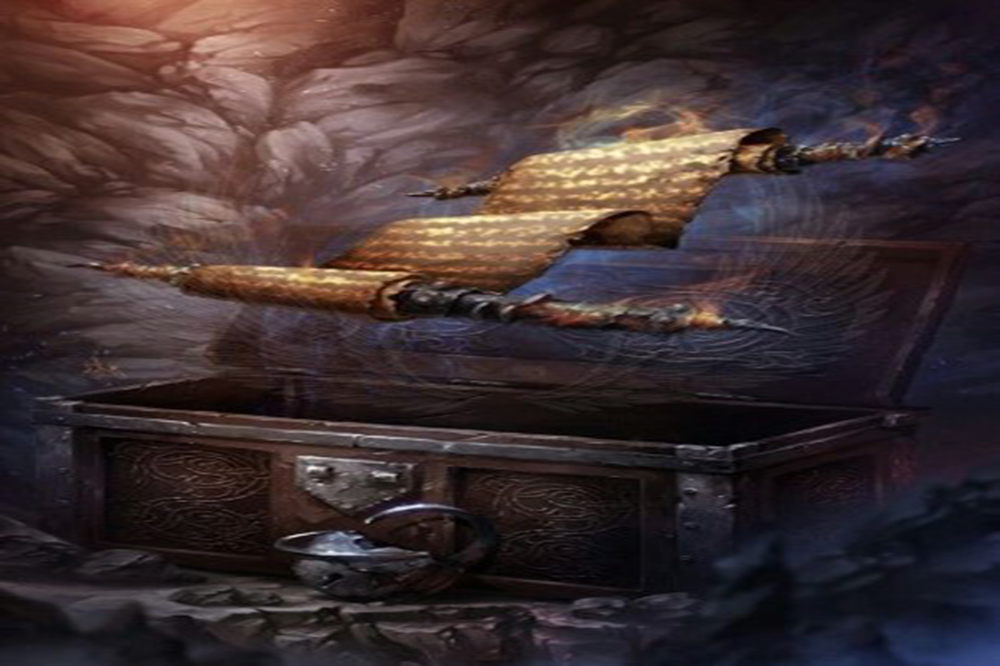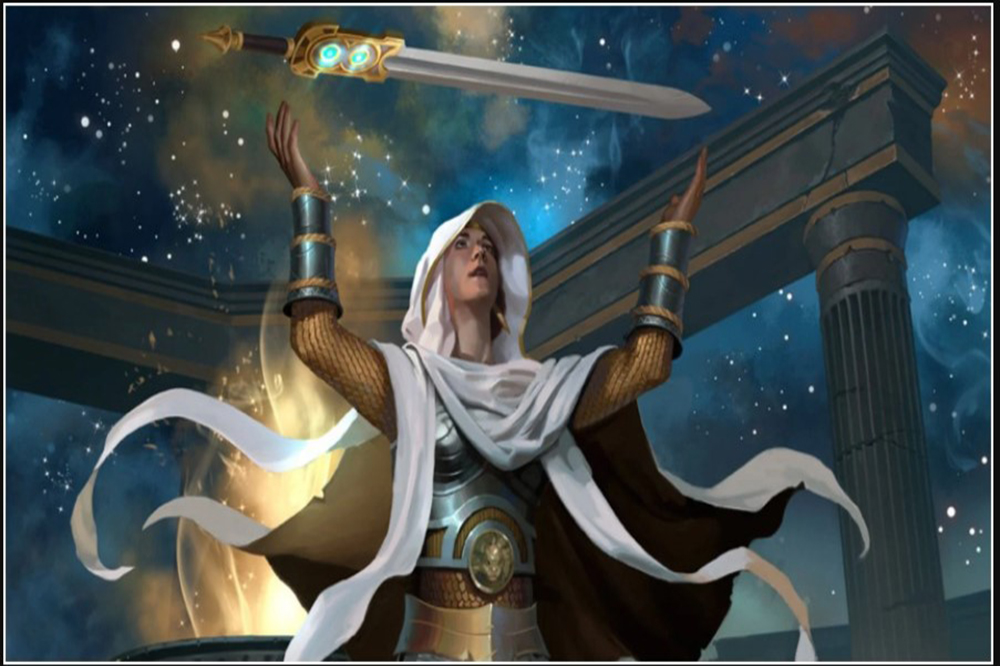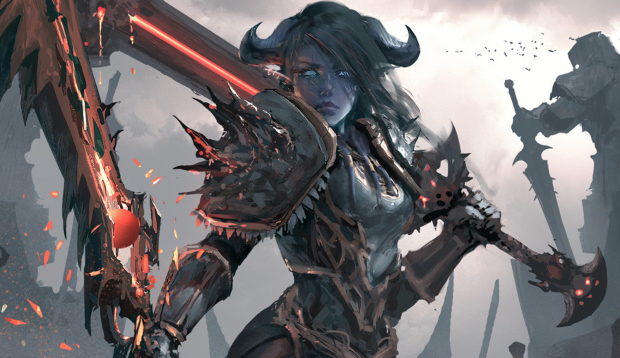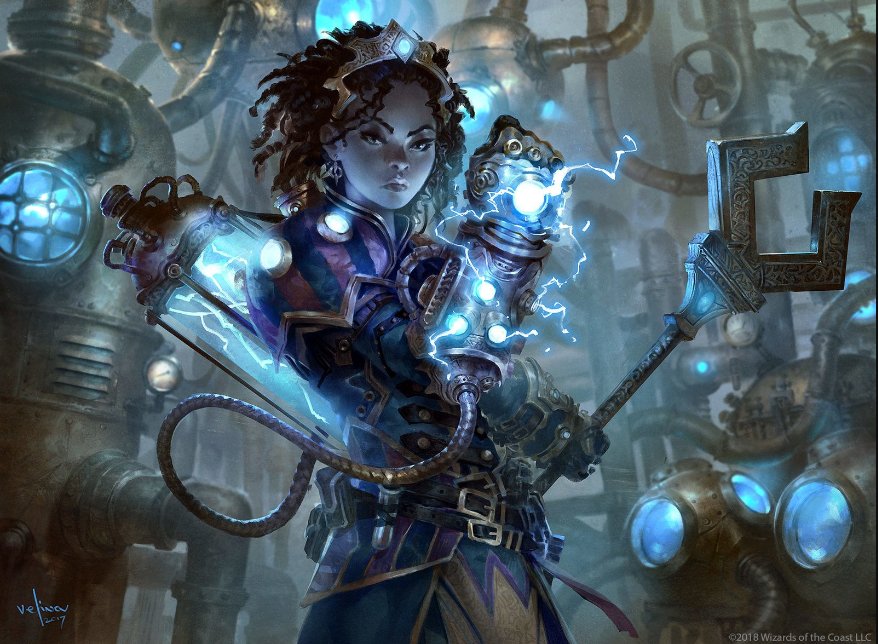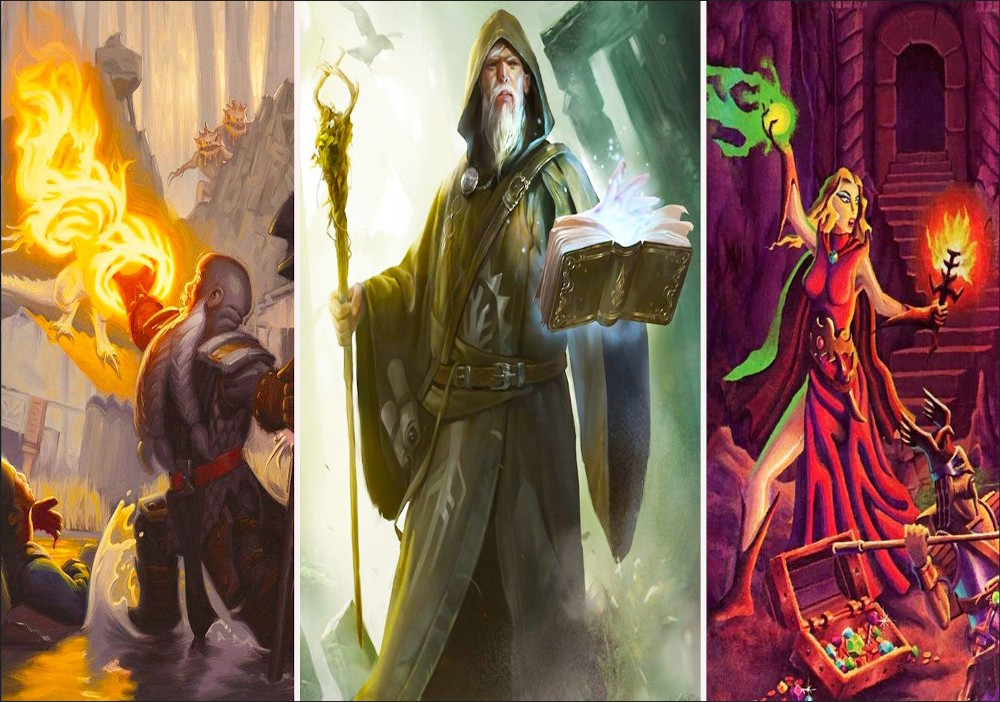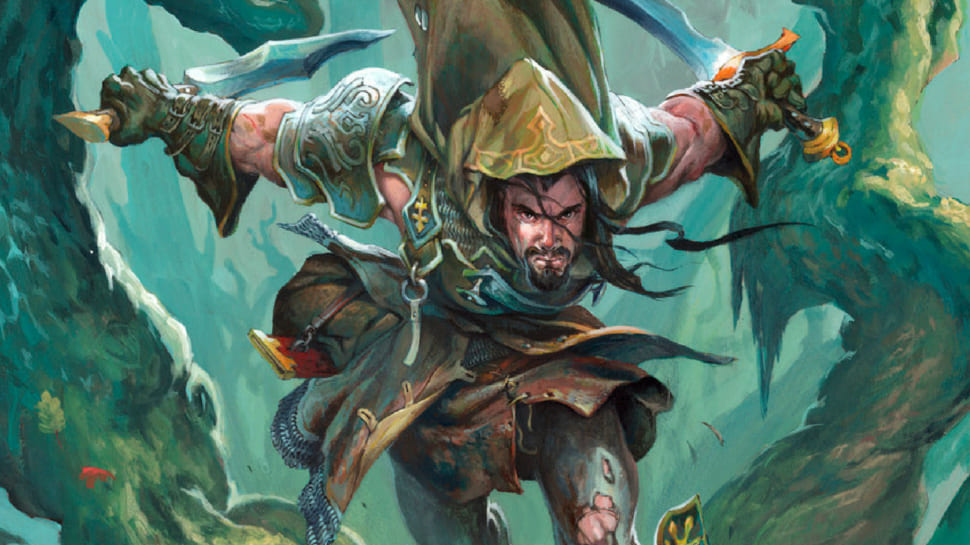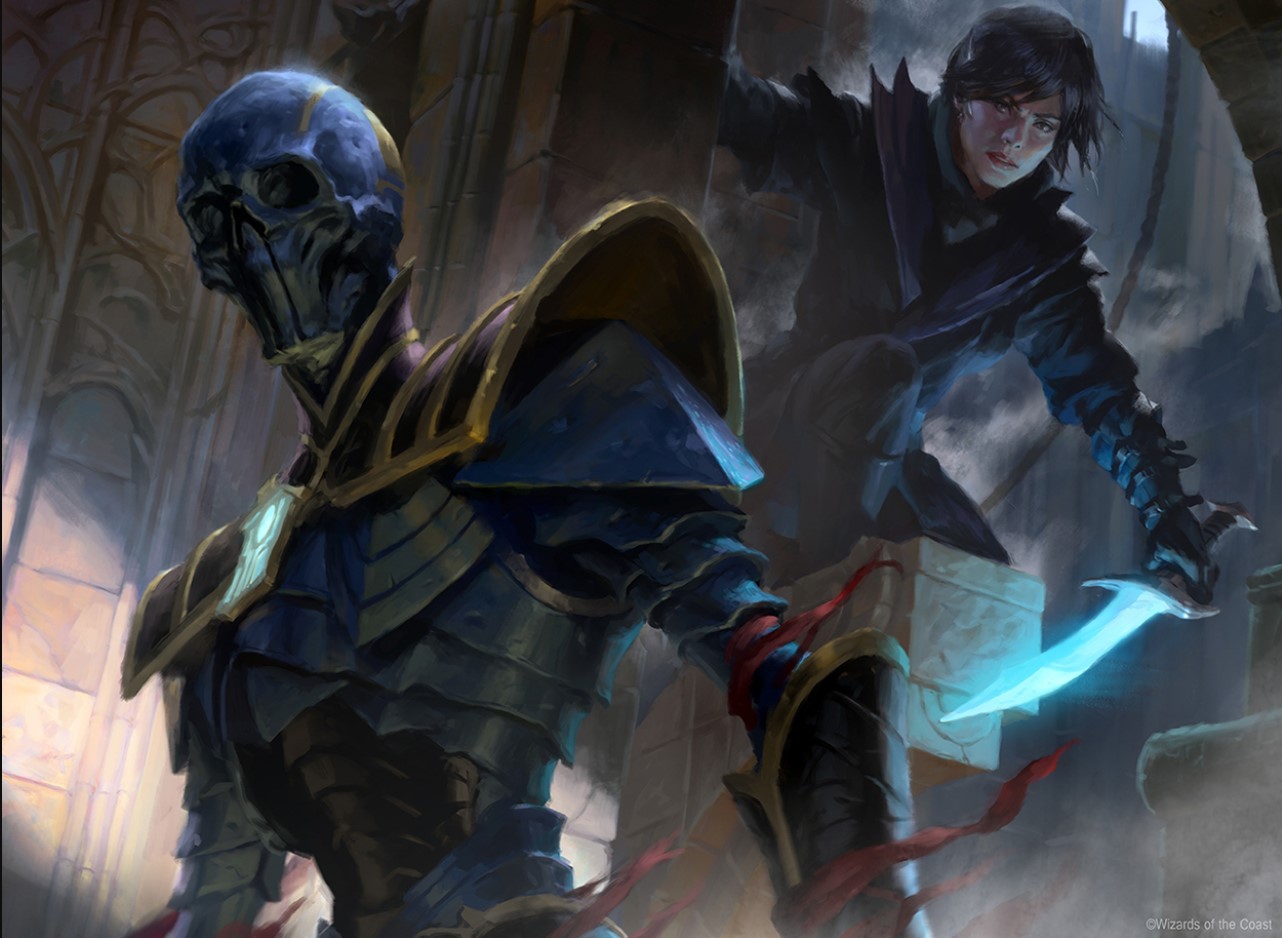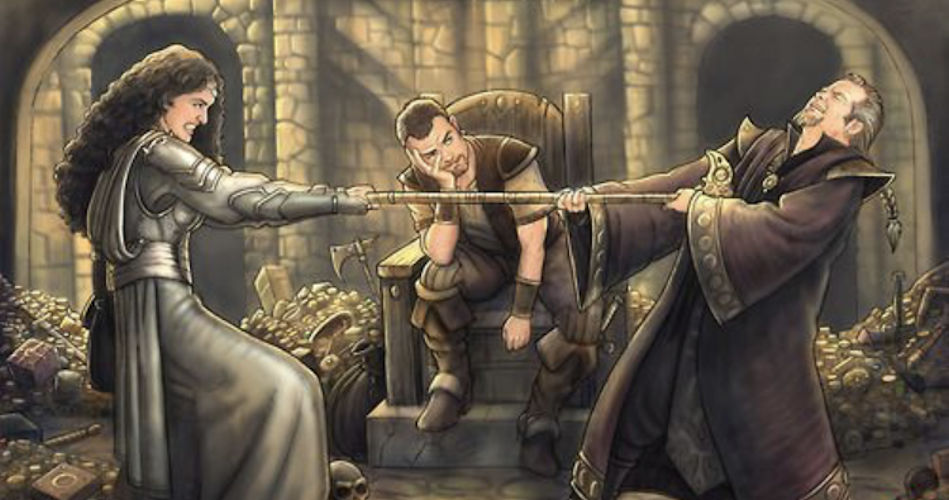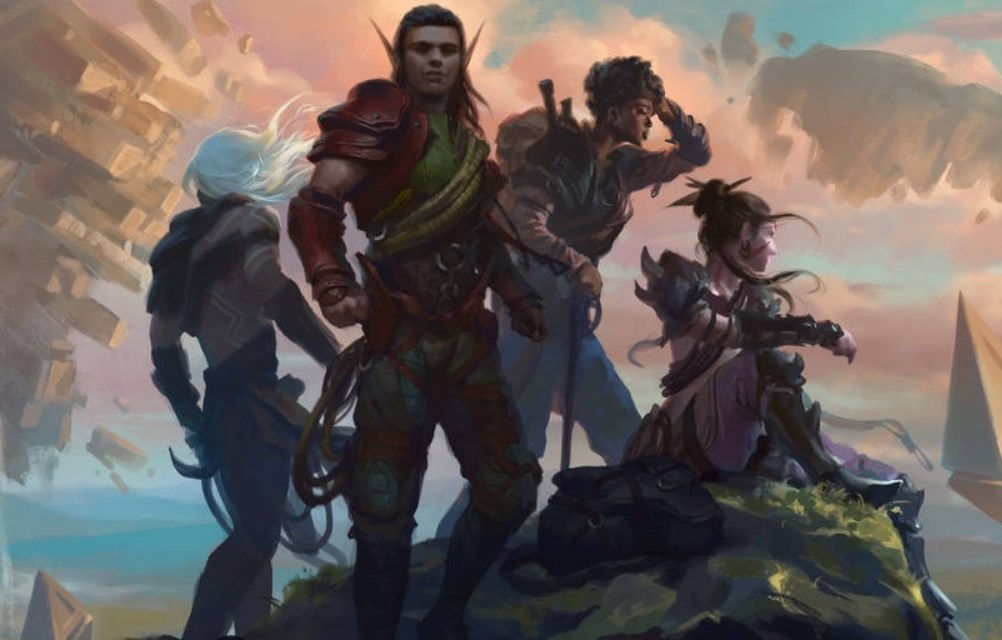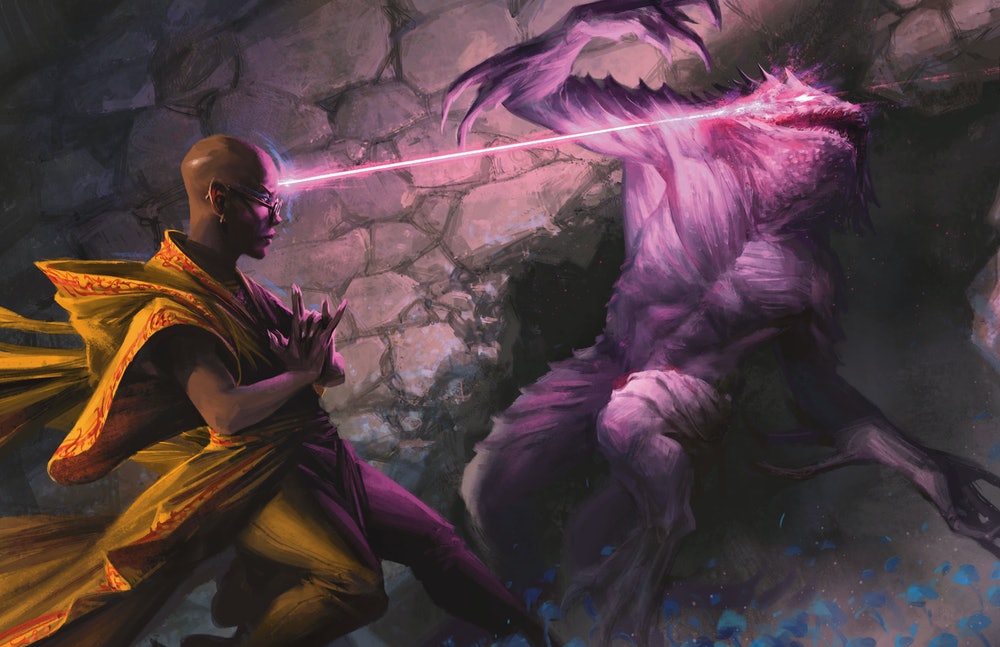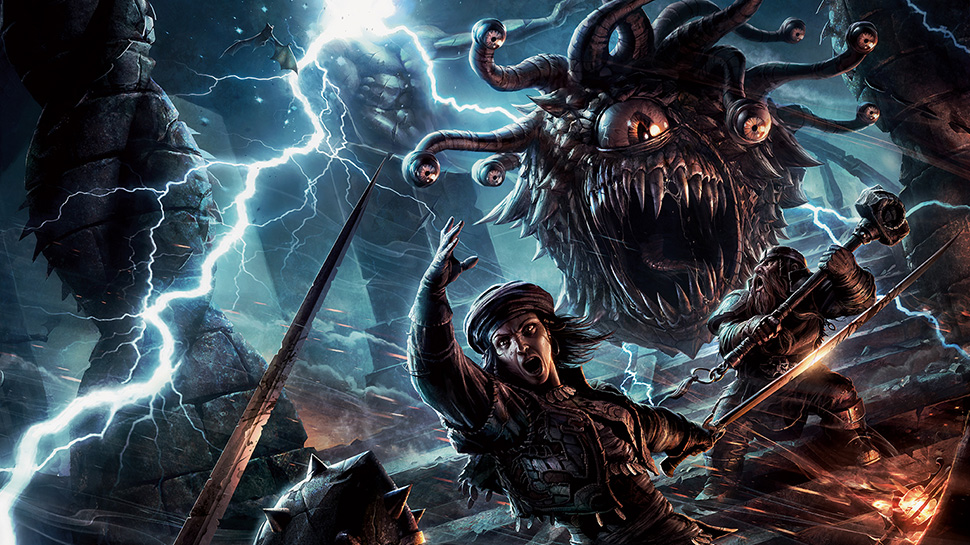
With fourteen total classes (twelve of them found in the general Player’s Handbook), it seems that Dungeons and Dragons has a limited amount of possibilities for character creation. Once you’ve played a bard or a rogue for the first time, isn’t that it? With the same pattern of mechanics and character progression, don’t character classes become repetitive and boring?
Subclasses provide additional characterization and variety to the base character classes. A monk may focus on healing, protection, damage, or support based on the subclass they choose. A cleric or warlock may choose a different patron with contrasting personalities, motives, or arcane abilities.
Here are my top fifteen subclasses to spice up your next D&D character and turn them into a class of their own.
15. College of Eloquence (Bard, TCoE)

Wizards of the Coast: Recruitment Officer by Johan Grenier
Bards are known for their prowess in charisma. They can turn the most hopeless of situations into their advantage by simply asking for it. College of Eloquence bards take this one step further by gaining enhanced skills to persuade and beguile.
With expertise over all languages and tongues, College of Eloquence bards can convince the masses to do their bidding. They can enchant themselves and allies, trip up their enemies, and gain useful abilities to inspire. They are excellent at twisting scenarios in their favor, turning a sure disadvantage into their moment of glory.
Bardic Inspiration is one of the bard’s most useful abilities. Mechanics-wise, these extra dice can tip the scales of fate, granting a bonus or hindrance just when you need it. In addition, the ability to speak to any being eloquently can lead to key plot moments within your campaign, taking you places you would never expect.
What College of Eloquence Bards Excel In...
- Charisma: Through either Persuasion or Deception, your bard will be able to convince just about anyone to do your bidding. Spur them on towards action or dissuade them from joining in the fight.
- Language: Your bard gains the ability to convince anyone to join their cause, even those who speak another language. They can also use their skills with words to unnerve their foes, distracting them from their nefarious deeds.
- Bardic Inspiration: Bardic Inspiration is a mighty skill, granting bonuses to friends to embolden them. College of Eloquence bards can now grant multi-use Inspirations and use their Inspiration to deter their foes.
Choose College of Eloquence If…
- You’re a bard
- You like to persuade the masses
- You know you have the perfect solution, if only someone would listen…
- You want to make Bardic Inspiration ridiculously powerful
Subclass details:
Adherents of the College of Eloquence master the art of oratory. Persuasion is regarded as a high art, and a well-reasoned, well-spoken argument often proves more powerful than objective truth. These bards wield a blend of logic and theatrical wordplay, winning over skeptics and detractors with logical arguments, and plucking at heartstrings to appeal to the emotions of entire audiences.
- Silver Tongue
- Starting at 3rd level, you are a master at saying the right thing at the right time. When you make a Charisma (Persuasion) or Charisma (Deception) check, you can treat a d20 roll of 9 or lower as a 10.
- Unsettling Words
- Also at 3rd level, you can spin words laced with magic that unsettle a creature and cause it to doubt itself. As a bonus action, you can expend one use of your Bardic Inspiration and choose one creature you can see within 60 feet of you. Roll the Bardic Inspiration die. The creature must subtract the number rolled from the next saving throw it makes before the start of your next turn.
- Unfailing Inspiration
- At 6th level, your inspiring words are so persuasive that others feel driven to succeed. When a creature adds one of your Bardic Inspiration dice to its ability check, attack roll, or saving throw and the roll fails, the creature can keep the Bardic Inspiration die.
- Universal Speech
- Also at 6th level, you have gained the ability to make your speech intelligible to any creature. As an action, choose one or more creatures within 60 feet of you, up to a number equal to your Charisma modifier (minimum of one creature). The chosen creatures can magically understand you, regardless of the language you speak, for 1 hour.
- Once you use this feature, you can't use it again until you finish a long rest, unless you expend a spell slot to use it again.
- Infectious Inspiration
- At 14th level, when you successfully inspire someone, the power of your eloquence can now spread to someone else. When a creature within 60 feet of you adds one of your Bardic Inspiration dice to its ability check, attack roll, or saving throw and the roll succeeds, you can use your reaction to encourage a different creature (other than yourself) that can hear you within 60 feet of you, giving it a Bardic Inspiration die without expending any of your Bardic Inspiration uses.
- You can use this reaction a number of times equal to your Charisma modifier (minimum of once), and you regain all expended uses when you finish a long rest.
College of Eloquence Power rating: 61/100
14. Wild Magic (Sorcerer, PHB)

Wizards of the Coast: Leyline Binding by Cristi Balanescu
Wild Magic feeds the chaotic energy inside of each one of us. Its unpredictability is part of its charm, opening up possibilities for incredible boons or terrible consequences. Wild Magic sorcerers play with this roll of the dice, chasing after the next great adventure.
Wild Magic rolls can be a blast to include in your campaigns. Even the best laid plans can be thrown by the wayside and insurmountable obstacles can be overcome with ease. In addition, Wild Magic sorcerers can gain spellcasting buffs and extra damage at higher levels.
Since it is so unpredictable, Wild Magic does not work in every campaign. But if you just want to have a laugh and roll the dice, Wild Magic is for you. Even less than optimal results can lead to great gameplay moments, so take a trip on the wild side and have fun!
What Wild Magic Sorcerers Excel In...
- Chaos: Wild Magic thrives on chaos. You never know what you’re going to get: boon, bust, or something in between!
- Rolling the dice: The Wild Magic table hosts a variety of random effects for you to activate. If you like games of chance and rolling the dice, this subclass is for you. Don’t blame me when you cast Fireball on yourself, though!
- Maximizing spell damage: In addition to your Wild Magic Surge, your sorcerer also gains advantage on a roll and, at high levels, bonus damage when you roll high for spell damage.
- Altering your fate: Who needs the hero’s journey? Wild Magic grants you the ability to choose your own destiny, whether it be buffing/debuffing another creature’s roll or turning into a potted plant.
Choose Wild Magic If…
- You’re a sorcerer
- You love chaos
- You’re a dice goblin and/or want more ways to use your d10
- You really want a beard of feathers
Subclass details:
Your innate magic comes from the wild forces of chaos that underlie the order of creation. You might have endured exposure to some form of raw magic, perhaps through a planar portal leading to Limbo, the Elemental Planes, or the mysterious Far Realm. Perhaps you were blessed by a powerful fey creature or marked by a demon. Or your magic could be a fluke of your birth, with no apparent cause. However it came to be, this chaotic magic churns within you, waiting for any outlet.
- Wild Magic Surge
- Starting when you choose this origin at 1st level, your spellcasting can unleash surges of untamed magic. Once per turn, the DM can have you roll a d20 immediately after you cast a sorcerer spell of 1st level or higher. If you roll a 1, roll on the Wild Magic Surge table to create a magical effect. If that effect is a spell, it is too wild to be affected by your Metamagic, and if it normally requires concentration, it doesn't require concentration in this case; the spell lasts for its full duration.
- Tides of Chaos
- Starting at 1st level, you can manipulate the forces of chance and chaos to gain advantage on one attack roll, ability check, or saving throw. Once you do so, you must finish a long rest before you can use this feature again.
- Any time before you regain the use of this feature, the DM can have you roll on the Wild Magic Surge table immediately after you cast a sorcerer spell of 1st level or higher. You then regain the use of this feature.
- Bend Luck
- Starting at 6th level, you have the ability to twist fate using your wild magic. When another creature you can see makes an attack roll, an ability check, or a saving throw, you can use your reaction and spend 2 sorcery points to roll 1d4 and apply the number rolled as a bonus or penalty (your choice) to the creature's roll. You can do so after the creature rolls but before any effects of the roll occur.
- Controlled Chaos
- At 14th level, you gain a modicum of control over the surges of your wild magic. Whenever you roll on the Wild Magic Surge table, you can roll twice and use either number.
- Spell Bombardment
- Beginning at 18th level, the harmful energy of your spells intensifies. When you roll damage for a spell and roll the highest number possible on any of the dice, choose one of those dice, roll it again and add that roll to the damage. You can use the feature only once per turn.
- Wild Magic Surge
- See Wild Magic table
- You regain all expended sorcery points.
Wild Magic Power rating: 64/100
13. Way of Mercy (Monk, TCoE)

Wizards of the Coast: Rootpath Purifier by Justyna Gil
Way of Mercy is for monks who want to lift others up, keeping your friends in the fight while also showing off your skills. Not all classes can heal, so an extra helping hand to patch up your allies is always useful. But Way of Mercy monks don’t lose out on their awesome abilities–they can fight with the best of them while also making sure everyone remains strong.
Way of Mercy sets your monk up for success in whatever scenario they find themselves in. The ability to heal others is especially useful in dangerous and unpredictable campaigns. Way of Mercy doesn’t only apply to healing, though–sometimes mercy to evildoers takes the form of damage and defeat.
In addition to healing, your monk gains a special mask to show the world their power! You can customize this mask either with the given table or make up a description yourself! You can play a Way of Mercy monk however you want, shaping your story to be one of altruism or of a duty to justice.
What Way of Mercy Monks Excel In...
- Healing: No healer? No worries! Way of Mercy allows your monk to heal their allies, even removing pesky status effects like poison.
- Balance: You’re here to help your friends and harm your enemies. Way of Mercy doesn’t negate your damage output, even allowing you to heal others as well as deal damage in the same turn.
- Masks: Character creation is all about the aesthetic. Way of Mercy monks gain a thematic mask to showcase their newfound arcane abilities. Choose your desired visage to let others know you mean business.
Choose Way of Mercy If…
- You’re a monk
- You want to heal your mates and/or there’s no healer in your party
- You love the vibe of the Merciful Mask
- You want to deal damage as well as heal
Subclass details:
Monks of the Way of Mercy learn to manipulate the life force of others to bring aid to those in need. They are wandering physicians to the poor and hurt. However, to those beyond their help, they bring a swift end as an act of mercy.
Those who follow the Way of Mercy might be members of a religious order, administering to the needy and making grim choices rooted in reality rather than idealism. Some might be gentle-voiced healers, beloved by their communities, while others might be masked bringers of macabre mercies.
The walkers of this way usually don robes with deep cowls, and they often conceal their faces with masks, presenting themselves as the faceless bringers of life and death.
- Implements of Mercy
- When you choose this tradition at 3rd level, you gain proficiency in the Insight and Medicine skills, and you gain proficiency with the herbalism kit.
- You also gain a special mask, which you often wear when using the features of this subclass. You determine its appearance, or generate it randomly by rolling on the Merciful Mask table.
| d6 | Mask Appearance |
|---|---|
| 1 | Raven |
| 2 | Black and white |
| 3 | Crying visage |
| 4 | Laughing visage |
| 5 | Skull |
| 6 | Butterfly |
- Hands of Healing
- At 3rd level, your mystical touch can mend wounds. As an action, you can spend 1 ki point to touch a creature and restore a number of hit points equal to a roll of your Martial Arts die + your Wisdom modifier.
- When you use your Flurry of Blows, you can replace one of the unarmed strikes with a use of this feature without spending a ki point for the healing.
- Hands of Harm
- At 3rd level, you use your ki to inflict wounds. When you hit a creature with an unarmed strike, you can spend 1 ki point to deal extra necrotic damage equal to one roll of your Martial Arts die + your Wisdom modifier. You can use this feature only once per turn.
- Physician's Touch
- Starting at 6th level, you can administer even greater cures with a touch, and if you feel it's necessary, you can use your knowledge to cause harm.
- When you use Hands of Healing on a creature, you can also end one disease or one of the following conditions affecting the creature: blinded, deafened, paralyzed, poisoned, or stunned.
- When you use Hands of Harm on a creature, you can subject that creature to the poisoned condition until the end of your next turn.
- Flurry of Healing and Harm
- Starting at 11th level, you can now mete out a flurry of comfort and hurt. When you use Flurry of Blows, you can now replace each of the unarmed strikes with a use of your Hands of Healing, without spending ki points for the healing.
- In addition, when you make an unarmed strike with Flurry of Blows, you can use Hand of Harm with that strike without spending the ki point for Hands of Harm. You can still use Hands of Harm only once per turn.
- Hand of Ultimate Mercy
- By 17th level, your mastery of life energy opens the door to the ultimate mercy. As an action, you can touch the corpse of a creature that died within the past 24 hours and expend 5 ki points. The creature then returns to life, regaining a number of hit points equal to 4d10 + your Wisdom modifier. If the creature died while subject to any of the following conditions, it revives with them removed: blinded, deafened, paralyzed, poisoned, and stunned.
- Once you use this feature, you can't use it again until you finish a long rest.
Way of Mercy Power rating: 67/100
12. Circle of the Moon (Druid, PHB)

Wizards of the Coast: Bog Badger by Sam Burley
Wild Shape is one of the most fun aspects of playing a druid. Being able to shapeshift into a whole host of creatures is such a powerful ability that can be used in a variety of ways, from stealth to combat to being just for laughs. Circle of the Moon strengthens the druid’s Wild Shape even further, allowing them more options and power as they level up.
Circle of the Moon druids gain access to higher level creatures to shift into, beginning with a giant spider and advancing to creatures as powerful as a young dragon or wyvern. In addition, Circle of the Moon druids can also transform into elementals, powerful spirits of other planes. Their attacks grow more powerful as they gain deeper connections to the natural world, taking on the magic in the very world around them.
Circle of the Moon buffs your druid’s existing abilities and throws a couple new skills into the mix. While other classes can only shapeshift through spellcasting, you have the natural ability to do so through your affinity for nature. At higher levels, you can even alter your basic appearance and boost your damage in battle.
What Circle of the Moon Druids Excel In...
- Wild Shape: Wild Shape is at the core of druidic abilities. Circle of the Moon makes your Wild Shape even more powerful, allowing you to shift into stronger and more deadly creatures.
- Shifting: In addition to Wild Shape bonuses, Circle of the Moon grants new forms to shift into, including elementals and eventually the ability to alter your appearance at will.
- Ferocity: Circle of the Moon isn’t just for flavor. Your new abilities buff your attacks and grant you extra damage in combat.
Choose Circle of the Moon If…
- You’re a druid
- You love shapeshifting
- You want your Wild Shape to be even more powerful
- You want to optimize your druid for combat
Subclass details:
Druids of the Circle of the Moon are fierce guardians of the wilds. Their order gathers under the full moon to share news and trade warnings. They haunt the deepest parts of the wilderness, where they might go for weeks on end before crossing paths with another humanoid creature, let alone another druid.
Changeable as the moon, a druid of this circle might prowl as a great cat one night, soar over the treetops as an eagle the next day, and crash through the undergrowth in bear form to drive off a trespassing monster. The wild is in the druid's blood.
- Combat Wild Shape
- When you choose this circle at 2nd level, you gain the ability to use Wild Shape on your turn as a bonus action, rather than as an action.
- Additionally, while you are transformed by Wild Shape, you can use a bonus action to expend one spell slot to regain 1d8 hit points per level of the spell slot expended.
- Circle Forms
- The rites of your circle grant you the ability to transform into more dangerous animal forms. Starting at 2nd level, you can use your Wild Shape to transform into a beast with a challenge rating as high as 1. You ignore the Max. CR column of the Beast Shapes table, but must abide by the other limitations there.
- Starting at 6th level, you can transform into a beast with a challenge rating as high as your druid level divided by 3, rounded down.
- Primal Strike
- Starting at 6th level, your attacks in beast form count as magical for the purpose of overcoming resistance and immunity to nonmagical attacks and damage.
- Elemental Wild Shape
- At 10th level, you can expend two uses of Wild Shape at the same time to transform into an air elemental, an earth elemental, a fire elemental, or a water elemental.
- Thousand Forms
- By 14th level, you have learned to use magic to alter your physical form in more subtle ways. You can cast the Alter Self spell at will.
Circle of the Moon Power rating: 69/100
11. Oathbreaker (Paladin, DMG)

Wizards of the Coast: Protect the Negotiators by Dominik Mayer
Oathbreakers are evil paladins, the holy warriors who stepped away from their oaths. They decided to turn back from their calling, instead diving into the shadows waiting on the other side. Through this, they gain dark powers and abilities, striking fear into the hearts of enemies and potentially allies alike.
While ruled as a fully evil subclass, Oathbreakers can be characterized as fallen heroes and those who struggle to find their place in the world. It doesn’t shy away from darker themes and can result in a very compelling storyline of self-acceptance and growth. It can also be used to fully embrace the villain role, gaining necromancy-themed abilities and fully becoming the monster that goes bump in the night.
Oathbreakers can be written as heroes or villains. The true power that comes with their subclass comes from the type of person who tells the story, the person who can control their fate. The subclass is not for everyone, but it does feature a host of neat abilities only found with more angsty characters.
What Oathbreaker Paladins Excel In...
- Dread: Oathbreakers are those who stepped away from their divine oath. In doing so, they became what they most hated, embodying doom and despair. They can even shape this ill-intent into arcane power.
- Necromancy: Oathbreakers primarily utilize necromancy spells, siphoning life force off of their foes. They can overpower undead and strike fear into the hearts of normal folk.
- Domination: Your paladin not only gains use of necromancy spells, but also spells that overpower the will of others. They can become true villains, shaping the world to their liking.
Choose Oathbreaker If…
- You’re a paladin
- You want the sweet angst of a good character turning evil
- You love necromancy spells and auras of darkness
- You just like the vibe
Subclass details:
An oathbreaker is a paladin who breaks their sacred oaths to pursue some dark ambition or serve an evil power. Whatever light burned in the paladin's heart has been extinguished. Only darkness remains.
A paladin must be evil and at least 3rd level to become an Oathbreaker. The paladin replaces the features specific to his or her Sacred Oath with Oathbreaker features.
- Oathbreaker Spells
- An Oathbreaker paladin loses previously gained oath spells and instead gains the following Oathbreaker spells at the paladin levels listed.
| Paladin Level | Spells |
|---|---|
| 3rd | Hellish Rebuke, Inflict Wounds |
| 5th | Crown of Madness, Darkness |
| 9th | Animate Dead, Bestow Curse |
| 13th | Blight, Confusion |
| 17th | Contagion, Dominate Person |
- Channel Divinity
- An Oathbreaker paladin of 3rd level or higher gains the following two Channel Divinity options.
- Control Undead. As an action, the paladin targets one undead creature her or she can see within 30 feet of him or her. The target must make a Wisdom saving throw. On a failed save, the target must obey the paladin’s commands for the next 24 hours, or until the paladin can use this Channel Divinity option again. An undead whose challenge rating is equal to or greater than the paladin’s level is immune to this effect.
- Dreadful Aspect. As an action, the paladin channels the darkest emotions and focuses them into a burst of magical menace. Each creature of the paladin’s choice within 30 feet of the paladin must make a Wisdom saving throw if it can see the paladin. On a failed save, the target is frightened of the paladin for 1 minute. If a creature frightened by this effect ends its turn more than 30 feet away from the paladin, it can attempt another Wisdom saving throw to end the effect on it.
- Aura of Hate
- Starting at 7th level, the paladin, as well any fiends and undead within 10 feet of the paladin, gains a bonus to melee weapon damage rolls equal to your Charisma modifier (minimum of +1). A creature can benefit from this feature from only one paladin at a time.
- At 18th level, the range of this aura increases to 30 feet.
- Supernatural Resistance
- At 15th level, the paladin gains resistance to bludgeoning, piercing, and slashing damage from nonmagical weapons.
- Dread Lord
- At 20th level, the paladin can, as an action, surround himself or herself with an aura of gloom that lasts for 1 minute. The aura reduces any bright light in a 30-foot radius around you to dim light. Whenever an enemy that is frightened by the paladin starts its turn in the aura, it takes 4d10 psychic damage. Additionally, the paladin and any creatures of the paladin’s choosing in the aura are draped in deeper shadow. Creatures that rely on sight have disadvantage on attack rolls against creatures draped in this shadow.
- While the aura lasts, the paladin can use a bonus action on his or her turn to cause the shadows in the aura to attack one creature. The paladin makes a melee spell attack against the target. If the attack hits, the target takes necrotic damage equal to 3d10 + the paladin’s Charisma modifier.
- After activating the aura, the paladin can't do so again until he or she finishes a long rest.
Oathbreaker Power rating: 70/100
10. Battle Master (Fighter, PHB)

Wizards of the Coast: Myrel, Shield of Argive by Ryan Pancoast
Fighters are the characters who do what it says on the tin–they fight, and they fight well. Battle Master expands the fighter’s repertoire, making combat both interesting and engaging to play. They also introduce new features to spice up the fighter’s basic abilities, granting them bonuses and strategic options.
The Battle Master maneuvers provide a wide variety of options for fighters in combat. They can distract, feint, riposte, and perform a whole host of other moves. They also gain a pool of special dice to use with these maneuvers. In addition, Battle Masters can gain knowledge about their opponents, exploiting their weaknesses through careful observation.
Combat can grow dull over time, which is a real shame. Battle Master works to spice up combat, granting a range of abilities and options to fully utilize your theater of the mind. This subclass is especially fun because it makes your battles more fun, driving the players to engage more and plan ahead.
What Battle Master Fighters Excel In...
- Maneuvers: Battle maneuvers are the highlight of the Battle Master subclass. While generic combat can tend to be stale, these maneuvers add variety and flair to your attacks.
- Combat superiority: Battle Master fighters also gain superiority dice to boost their abilities. They can spend these on maneuvers, both to buff themselves and distract their opponents.
- Insight: After careful observation, you can learn key info about the enemies you’re facing. You can then shape your own attacks accordingly, hitting your enemies right where it hurts.
- Finesse: Due to the variety of your maneuvers and your prowess in battle, your fighter will become a true master of combat. As you grow in power, so too will your Battle Master abilities, allowing you to hit harder and spice up your attacks.
Choose Battle Master If…
- You’re a fighter
- You want more options in combat
- You feel superior
- You want to discover your enemy’s weaknesses
Subclass details:
Those who emulate the archetypal Battle Master employ martial techniques passed down through generations. To a Battle Master, combat is an academic field, sometimes including subjects beyond battle such as weaponsmithing and calligraphy. Not every fighter absorbs the lessons of history, theory, and artistry that are reflected in the Battle Master archetype, but those who do are well-rounded fighters of great skill and knowledge.
- Combat Superiority
- When you choose this archetype at 3rd level, you learn maneuvers that are fueled by special dice called superiority dice.
- Maneuvers. You learn three maneuvers of your choice. Many maneuvers enhance an attack in some way. You can use only one maneuver per attack.
- You learn two additional maneuvers of your choice at 7th, 10th, and 15th level. Each time you learn new maneuvers, you can also replace one maneuver you know with a different one.
- Superiority Dice. You have four superiority dice, which are d8s. A superiority die is expended when you use it. You regain all of your expended superiority dice when you finish a short or long rest.
- You gain another superiority die at 7th level and one more at 15th level.
- Saving Throws. Some of your maneuvers require your target to make a saving throw to resist the maneuver's effects. The saving throw DC is calculated as follows:
- Maneuver save DC = 8 + your proficiency bonus + your Strength or Dexterity modifier (your choice)
- Student of War
- At 3rd level, you gain proficiency with one type of artisan's tools of your choice.
- Know Your Enemy
- Starting at 7th level, if you spend at least 1 minute observing or interacting with another creature outside combat, you can learn certain information about its capabilities compared to your own. The DM tells you if the creature is your equal, superior, or inferior in regard to two of the following characteristics of your choice:
- Strength score
- Dexterity score
- Constitution score
- Armor Class
- Current hit points
- Total class levels, if any
- Fighter class levels, if any
- Starting at 7th level, if you spend at least 1 minute observing or interacting with another creature outside combat, you can learn certain information about its capabilities compared to your own. The DM tells you if the creature is your equal, superior, or inferior in regard to two of the following characteristics of your choice:
- Improved Combat Superiority
- At 10th level, your superiority dice turn into d10s. At 18th level, they turn into d12s.
- Relentless
- Starting at 15th level, when you roll initiative and have no superiority dice remaining, you regain 1 superiority die.
Battle Master Power rating: 73/100
9. School of Divination (Wizard, PHB)

Wizards of the Coast: Hurkyl, Master Wizard by Randy Vargas
Do you ever want to look into the future? Wizards of the School of Divination devote their whole lives to just that–glimpsing into what is yet to come. They learn how to see what no one should see, then shape their destinies to their will.
School of Divination wizards can get quite meta, catching glimpses of what is yet to come. They can pick apart weaknesses in their enemies and utilize their spellcasting to alter the world around them. They can also gain special abilities like darkvision and sight into the Ethereal Plane, seeing the fabric of the universe.
School of Divination wizards can be a load of fun to play and to DM with. DMs can set up elaborate storylines inaccessible to average adventurers, and these wizards can solve mind bending puzzles to reveal hidden clues. They can use their abilities to mess with their opponents, toying with them just as they toy with the fates.
What School of Divination Wizards Excel In...
- Augury: Divination is all about seeing what is yet to come. You can use your newfound abilities to take a sneak peek into your enemies’ actions as well as being able to alter the roll of fate.
- Spellcasting: Divination is a class all to itself, literally! Wizards who focus on Divination magic become quicker, more skilled, and even regain spell slots for using their arcane specialty.
- Foresight: Take a peek into other planes and see things that are hidden from mortal means. School of Divination allows you to gain sight in the dark, see through magical illusions, and glimpse into another plane.
Choose School of Divination If…
- You’re a wizard
- You want to know the future
- You want even more powerful wizard spells
- You want to see into other planes
Subclass details:
The counsel of a diviner is sought by royalty and commoners alike, for all seek a clearer understanding of the past, present, and future. As a diviner, you strive to part the veils of space, time, and consciousness so that you can see clearly. You work to master spells of discernment, remote viewing, supernatural knowledge, and foresight.
- Divination Savant
- Beginning when you select this school at 2nd level, the gold and time you must spend to copy a Divination spell into your spellbook is halved.
- Portent
- Starting at 2nd level when you choose this school, glimpses of the future begin to press in on your awareness. When you finish a long rest, roll two d20s and record the numbers rolled. You can replace any attack roll, saving throw, or ability check made by you or a creature that you can see with one of these foretelling rolls. You must choose to do so before the roll, and you can replace a roll in this way only once per turn.
- Each foretelling roll can be used only once. When you finish a long rest, you lose any unused foretelling rolls.
- Expert Divination
- Beginning at 6th level, casting divination spells comes so easily to you that it expends only a fraction of your spellcasting efforts. When you cast a divination spell of 2nd level or higher using a spell slot, you regain one expended spell slot. The slot you regain must be of a level lower than the spell you cast and can't be higher than 5th level.
- The Third Eye
- Starting at 10th level, you can use your action to increase your powers of perception. When you do so, choose one of the following benefits, which lasts until you are incapacitated or you take a short or long rest. You can't use the feature again until you finish a short or long rest.
- Darkvision. You gain darkvision out to a range of 60 feet.
- Ethereal Sight. You can see into the Ethereal Plane within 60 feet of you.
- Greater Comprehension. You can read any language.
- See Invisibility. You can see invisible creatures and objects within 10 feet of you that are within line of sight.
- Starting at 10th level, you can use your action to increase your powers of perception. When you do so, choose one of the following benefits, which lasts until you are incapacitated or you take a short or long rest. You can't use the feature again until you finish a short or long rest.
- Greater Portent
- Starting at 14th level, the visions in your dreams intensify and paint a more accurate picture in your mind of what is to come. You roll three d20s for your Portent feature, rather than two.
School of Divination Power rating: 77/100
8. Path of the Totem Warrior (Barbarian, PHB)

Wizards of the Coast: Runadi, Behemoth Caller by Billy Christian
Symbolism is a powerful writing tool to convey messages in a simple and beautiful way. Path of the Totem Warrior barbarians take this symbolism literally, gaining actual artifacts and features of the spirits they emulate. Their newfound powers grant them the skills of animals and the resilience to fight as they do.
There is a wide variety of options for the Path of the Totem Warrior barbarian to choose from. They can be swift, strong, stealthy, athletic, wise, or any combination of the above. These powers can be reflected in your appearance and in the artifacts/weapons you utilize. You can also call upon the spirits of the animals you draw power from, summoning them to fight by your side.
Take full advantage of the storytelling medium at your disposal! Create your character to suit your playstyle and the story you want to share. You can mix and match which totem spirits you gain abilities from, taking the best of every level.
What Path of the Totem Warrior Barbarians Excel In...
- Rage: You would like to rage! Gain special abilities and boosts by drawing upon your totem animal during your characteristic rage.
- Symbolism: Each Path of the Totem Warrior is a little different. Do you want to see ahead and strike quickly with the totem of the eagle, or take and deal damage like a tank with the totem of the bear? Branch out and choose what animal suits you the best.
- Bestial abilities: Each totem animal grants you a special ability as you level. You’re not stuck with one style, though–if you’d like, you can take a different totem animal each time, granting you the best of everything.
- Spiritual attunement: Path of the Totem Warrior grants you a special connection with the spirit realm. Use your newfound abilities to draw closer to the natural world around you and draw strength from its spirits.
Choose Path of the Totem Warrior If…
- You’re a barbarian
- You love symbolism
- You love optimization
- You want special abilities connected to animals
- You want to draw upon the magic in the world
Subclass details:
The Path of the Totem Warrior is a spiritual journey, as the barbarian accepts a spirit animal as guide, protector, and inspiration. In battle, your totem spirit fills you with supernatural might, adding magical fuel to your barbarian rage.
Most barbarian tribes consider a totem animal to be kin to a particular clan. In such cases, it is unusual for an individual to have more than one totem animal spirit, though exceptions exist.
- Spirit Seeker
- Yours is a path that seeks attunement with the natural world, giving you a kinship with beasts. At 3rd level when you adopt this path, you gain the ability to cast the Beast Sense and Speak with Animals spells, but only as rituals.
- Totem Spirit
- At 3rd level, when you adopt this path, you choose a totem spirit and gain its feature. You must make or acquire a physical totem object – an amulet or similar adornment – that incorporates fur or feathers, claws, teeth, or bones of the totem animal. At your option, you also gain minor physical attributes that are reminiscent of your totem spirit. For example, if you have a bear totem spirit, you might be unusually hairy and thick-skinned, or if your totem is the eagle, your eyes turn bright yellow.
- Your totem animal might be an animal related to those listed here but more appropriate to your homeland. For example, you could choose a hawk or vulture in place of an eagle.
- Bear. While raging, you have resistance to all damage except psychic damage. The spirit of the bear makes you tough enough to stand up to any punishment.
- Eagle. While you're raging and aren't wearing heavy armor, other creatures have disadvantage on opportunity attack rolls against you, and you can use the Dash action as a bonus action on your turn. The spirit of the eagle makes you into a predator who can weave through the fray with ease.
- Elk. While you're raging and aren't wearing heavy armor, your walking speed increases by 15 feet. The spirit of the elk makes you extraordinarily swift.
- Tiger. While raging, you can add 10 feet to your long jump distance and 3 feet to your high jump distance. The spirit of the tiger empowers your leaps.
- Wolf. While you're raging, your friends have advantage on melee attack rolls against any creature within 5 feet of you that is hostile to you. The spirit of the wolf makes you a leader of hunters.
- Aspect of the Beast
- At 6th level, you gain a magical benefit based on the totem animal of your choice. You can choose the same animal you selected at 3rd level or a different one.
- Bear. You gain the might of a bear. Your carrying capacity (including maximum load and maximum lift) is doubled, and you have advantage on Strength checks made to push, pull, lift, or break objects.
- Eagle. You gain the eyesight of an eagle. You can see up to 1 mile away with no difficulty, able to discern even fine details as though looking at something no more than 100 feet away from you. Additionally, dim light doesn't impose disadvantage on your Wisdom (Perception) checks.
- Elk. Whether mounted or on foot, your travel pace is doubled, as is the travel pace of up to ten companions while they're within 60 feet of you and you're not incapacitated. The elk spirit helps you roam far and fast.
- Tiger. You gain proficiency in two skills from the following list: Athletics, Acrobatics, Stealth, and Survival. The cat spirit hones your survival instincts.
- Wolf. You gain the hunting sensibilities of a wolf. You can track other creatures while traveling at a fast pace, and you can move stealthily while traveling at a normal pace.
- At 6th level, you gain a magical benefit based on the totem animal of your choice. You can choose the same animal you selected at 3rd level or a different one.
- Spirit Walker
- At 10th level, you can cast the Commune with Nature spell, but only as a ritual. When you do so, a spiritual version of one of the animals you chose for Totem Spirit or Aspect of the Beast appears to you to convey the information you seek.
- Totemic Attunement
- At 14th level, you gain a magical benefit based on a totem animal of your choice. You can choose the same animal you selected previously or a different one.
- Bear. While you're raging, any creature within 5 feet of you that's hostile to you has disadvantage on attack rolls against targets other than you or another character with this feature. An enemy is immune to this effect if it can't see or hear you or if it can't be frightened.
- Eagle. While raging, you have a flying speed equal to your current walking speed. This benefit works only in short bursts; you fall if you end your turn in the air and nothing else is holding you aloft.
- Elk. While raging, you can use a bonus action during your move to pass through the space of a Large or smaller creature. That creature must succeed on a Strength saving throw (DC 8 + your Strength bonus + your proficiency bonus) or be knocked prone and take bludgeoning damage equal to 1d12 + your Strength modifier.
- Tiger. While you're raging, if you move at least 20 feet in a straight line toward a Large or smaller target right before making a melee weapon attack against it, you can use a bonus action to make an additional melee weapon attack against it.
- Wolf. While you're raging, you can use a bonus action on your turn to knock a Large or smaller creature prone when you hit it with a melee weapon attack.
- At 14th level, you gain a magical benefit based on a totem animal of your choice. You can choose the same animal you selected previously or a different one.
Path of the Totem Warrior Power rating: 80/100
7. Beast Master Conclave (Ranger, PHB)

Wizards of the Coast: Allosaurus Shepherd by Douglas Shuler
Animal companions brighten our lives in the real world, providing a friend, comfort, and laughter. Beast Master Conclave rangers bring their animal companions along on their adventures, allowing them to fight by their side. They also form special bonds with these companions, granting even more abilities when joining forces.
Beast Master Conclave rangers can take on a variety of animal companions, from a bear to a hawk to a spirit of nature. Each animal works harmoniously with their player, becoming their eyes or ears or claws. They are completely loyal and can grant special bonuses when fighting, boosting your character and party to victory.
Even though rangers are often solitary hunters and warriors, there is a level of comfort in knowing an animal companion will always have your back. You can fight alongside other creatures of the wilds or summon the great spirits of nature. Either way, you’ll have a friend for life who will help you rout out the evil in the world.
What Beast Master Conclave Rangers Excel In...
- Animal kinship: Rangers have a strong affinity for the natural world around them. With Beast Master Conclave, you gain a bestial partner to join you in your battles to save (or maybe destroy) the world.
- Combat companions: In addition to animal companions, your ranger can summon a primal beast, one of the spirits of nature. These beasts are specialized to the elements and have enhanced abilities beyond average creatures.
- Nature affinity: Beast Master Conclave rangers also gain special fighting styles and combat enhancements when fighting together. It always helps to have a friend at your side!
Choose Beast Master Conclave If…
- You are a ranger
- You want to bring your pet along on adventures
- You want your animal companion to fight with you
- You want to summon primal beasts from the very spirits of nature
Subclass details:
The Beast Master archetype embodies a friendship between the civilized races and the beasts of the world. United in focus, beast and ranger work as one to fight the monstrous foes that threaten civilization and the wilderness alike. Emulating the Beast Master archetype means committing yourself to this ideal, working in partnership with an animal as its companion and friend.
- Ranger's Companion
- At 3rd level, you gain a beast companion that accompanies you on your adventures and is trained to fight alongside you. Choose a beast that is no larger than Medium and that has a challenge rating of 1/4 or lower (appendix D presents statistics for the hawk, mastiff, and panther as examples). Add your proficiency bonus to the beast’s AC, attack rolls, and damage rolls, as well as to any saving throws and skills it is proficient in. Its hit point maximum equals its normal maximum or four times your ranger level, whichever is higher. Like any creature, the beast can spend Hit Dice during a short rest.
- The beast obeys your commands as best as it can. It takes its turn on your initiative. On your turn, you can verbally command the beast where to move (no action required by you). You can use your action to verbally command it to take the Attack, Dash, Disengage, or Help action. If you don’t issue a command, the beast takes the Dodge action. Once you have the Extra Attack feature, you can make one weapon attack yourself when you command the beast to take the Attack action. While traveling through your favored terrain with only the beast, you can move stealthily at a normal pace.
- If you are incapacitated or absent, the beast acts on its own, focusing on protecting you and itself. The beast never requires your command to use its reaction, such as when making an opportunity attack.
- While traveling through your favored terrain with only the beast, you can move stealthily at a normal pace.
- If the beast dies, you can obtain a new companion by spending 8 hours magically bonding with another beast that isn’t hostile to you and that meets the requirements.
- Primal Companion (Optional, TCoE)
- This 3rd-level feature replaces the Ranger's Companion feature.
- You magically summon a primal beast, which draws strength from your bond with nature. The beast is friendly to you and your companions and obeys your commands. Choose its stat block-Beast of the Land, Beast of the Sea, or Beast of the Sky-which uses your proficiency bonus (PB) in several places. You also determine the kind of animal the beast is, choosing a kind appropriate for the stat block. Whatever kind you choose, the beast bears primal markings, indicating its mystical origin.
- In combat, the beast acts during your turn. It can move and use its reaction on its own, but the only action it takes is the Dodge action, unless you take a bonus action on your turn to command it to take another action. That action can be one in its stat block or some other action. You can also sacrifice one of your attacks when you take the Attack action to command the beast to take the Attack action. If you are incapacitated, the beast can take any action of its choice, not just Dodge.
- If the beast has died within the last hour, you can use your action to touch it and expend a spell slot of 1st level or higher. The beast returns to life after 1 minute with all its hit points restored. When you finish a long rest, you can summon a different primal beast. The new beast appears in an unoccupied space within 5 feet of you, and you choose its stat block and appearance. If you already have a beast from this feature, it vanishes when the new beast appears. The beast also vanishes if you die.
- Beast of the Land
- Beast of the Sea
- Beast of the Sky
- Exceptional Training
- Beginning at 7th level, on any of your turns when your beast companion doesn’t attack, you can use a bonus action to command the beast to take the Dash, Disengage, or Help action on its turn. In addition, the beast’s attacks now count as magical for the purpose of overcoming resistance and immunity to nonmagical attacks and damage.
- Bestial Fury
- Starting at 11th level, when you command your beast companion to take the Attack action, the beast can make two attacks, or it can take the Multiattack action if it has that action.
- Share Spells
- Beginning at 15th level, when you cast a spell targeting yourself, you can also affect your beast companion with the spell if the beast is within 30 feet of you.
Beast Master Power rating: 81/100
6. Aberrant Mind (Sorcerer, TCoE)

Wizards of the Coast: Thought Scour by Julie Dillon
Aberrant Mind sorcerers dip into the ancient powers just beyond the known world. These powers strengthen (or weaken) their mind, giving them access to powerful abilities like telekinesis. These powers can be used for good or for ill, allowing you to see into the unknown and subtly influence the worlds beyond.
Psionic spells grant you extra spells beyond the sorcerer’s basic abilities. In addition to these spells, you can speak through your mind, forming bonds with allies and unnerving enemies. In extreme circumstances, you warp your very being, gaining supernatural abilities as well as aberrant features.
Aberrant Mind sorcerers open up a whole new playing field for your character. Instead of wondering if you managed to convince someone or wishing you had contact with a powerful ally, you can look into their minds to learn the truth. You can also lean into the otherworldly nature of your powers by embracing the unnerving abilities and features.
What Aberrant Mind Sorcerers Excel In...
- Telepathic powers: Aberrant Mind sorcerers can speak inside your mind! View surface level thoughts and risk to dive even deeper, revealing the secrets locked away. Aberrant Mind sorcerers also gain specialized defenses to prevent their enemies from twisting their own thoughts.
- Psychic links: Form bonds with friends and enemies alike through psychic connections. These can be very practical across long distances or in dangerous scenarios. Aberrant Mind sorcerers also specialize in psychic spells, messing with the minds of their foes.
- Otherworldly influences: These telepathic abilities had to come from somewhere. Which ancient powers did you stumble across or beckon to your side?
- Superhuman abilities: Aberrant Mind sorcerers can do more than talk in your head. They can warp their bodies to suit the environments around them, gaining specialized features for a brief time.
Choose Aberrant Mind If…
- You’re a sorcerer
- You want telepathy
- You want to defeat your enemies from the inside
- You love eldritch horrors
Subclass details:
An alien influence has wrapped its tendrils around your mind, giving you psionic power. You can now touch other minds with that power and alter the world around you by using it to control the magical energy of the multiverse. Will this power shine from you as a hopeful beacon to others? Or will you be a source of terror to those who feel the stab of your mind and witness the strange manifestations of your might?
As an Aberrant Mind sorcerer, you decide how you acquired your powers. Were you born with them? Or did an event later in life leave you shining with psionic awareness? Consult the Aberrant Origins table for a possible origin of your power.
- Aberrant Origins (see table)
| Sorcerer Level | Spells |
|---|---|
| 1st | Arms of Hadar, Dissonant Whispers, Mind Sliver |
| 3rd | Calm Emotions, Detect Thoughts |
| 5th | Hunger of Hadar, Sending |
| 7th | Evard's Black Tentacles, Summon Aberration |
| 9th | Rary's Telepathic Bond, Telekinesis |
- Telepathic Speech
- Starting at 1st level, you can form a telepathic connection between your mind and the mind of another. As a bonus action, choose one creature you can see within 30 feet of you. You and the chosen creature can speak telepathically with each other while the two of you are within a number of miles of each other equal to your Charisma modifier (minimum of 1 mile). To understand each other, you each must speak mentally in a language the other knows.
- The telepathic connection lasts for a number of minutes equal to your sorcerer level. It ends early if you are incapacitated or die or if you use this ability to form a connection with a different creature.
- Psionic Sorcery
- Beginning at 6th level, when you cast any spell of 1st level or higher from your Psionic Spells feature, you can cast it by expending a spell slot as normal or by spending a number of sorcery points equal to the spell's level. If you cast the spell using sorcery points, it requires no verbal or somatic components, and it requires no material components, unless they are consumed by the spell.
- Psychic Defenses
- At 6th level, you gain resistance to psychic damage, and you have advantage on saving throws against being charmed or frightened.
- Revelation in Flesh
- Beginning at 14th level, you can unleash the aberrant truth hidden within yourself. As a bonus action, you can spend 1 or more sorcery points to magically transform your body for 10 minutes. For each sorcery point you spend, you can gain one of the following benefits of your choice, the effects of which last until the transformation ends:
- You can see any invisible creature within 60 feet of you, provided it isn't behind total cover. Your eyes also turn black or become writhing sensory tendrils.
- You gain a flying speed equal to your walking speed and can hover. As you fly, your skin glistens with mucus or shines with an otherworldly light.
- You gain a swimming speed equal to twice your walking speed, and you can breathe underwater. Moreover, gills grow from your neck or fan out from behind your ears, your fingers become webbed, or you grow writhing cilia that extend through your clothing.
- Your body, along with any equipment you are wearing or carrying, becomes slimy and pliable. You can move through any space as narrow as 1 inch without squeezing, and you can spend 5 feet of movement to escape from nonmagical restraints or being grappled.
- Beginning at 14th level, you can unleash the aberrant truth hidden within yourself. As a bonus action, you can spend 1 or more sorcery points to magically transform your body for 10 minutes. For each sorcery point you spend, you can gain one of the following benefits of your choice, the effects of which last until the transformation ends:
- Warping Implosion
- At 18th level, you can unleash your aberrant power as a space-warping anomaly. As an action, you can teleport to an unoccupied space you can see within 120 feet of you. Immediately after you disappear, each creature within 30 feet of the space you left must make a Strength saving throw. On a failed save, a creature takes 3d10 force damage and is pulled straight toward the space you left, ending in an unoccupied space as close to your former space as possible. On a successful save, the creature takes half as much damage and isn't pulled.
- Once you use this feature, you can't do so again until you finish a long rest, unless you spend 5 sorcery points to use it again.
Aberrant Mind Power rating: 86/100
5. Armorer (Artificer, TCoE)

Wizards of the Coast: Precision Bolt by Grzegorz Rutkowski
Artificers are builders and creators, designing contraptions and weapons the world has never seen before. Armorer artificers specialize in defense and arcane enhancements, giving them protection against the most terrible foes. They also gain specialized abilities to utilize both in and out of combat, giving them bonuses for heavy attacks and subtle maneuvers.
Armorers specialize in more than just defense. They can boost their armor for dealing massive damage and imbue it with arcane energy. The Guardian armor turns them into a tank to deal damage upon the front lines, while the Infiltrator armor allows them to sneak quickly and grant disadvantage to your enemies. Through their in-depth craftsmanship, they gain specialization with their tools and magic, giving them more options for any scenario.
While the Artillerist subclass shows off a handful of flashy features and new toys, the Armorer artificer grants a wider variety of abilities to buff your character. They can cast lightning, speed past obstacles, and apply separate enchantments to each article of armor. Armorer is the most practical and hearty of the artificer subclasses, granting you the best of every feature.
What Armorer Artificers Excel In...
- Protection: Armorers excel in crafting the best possible defense, both for themselves and their allies. They create a strong connection with their armor, enhancing it to suit their needs and keep them safe from harm.
- Tinkering: In addition to ordinary armor, you can add special bonuses and features to your creations. These bonuses are specialized to a certain build, like Guardian or Infiltrator. Pick the one that suits your playstyle the best.
- Arcane enhancement: The armor of an Armorer is bursting with arcane power! Cast spells and gain magical enchantments to each piece of armor you craft. Utilize these spells in combat to strike when your enemy least expects it.
- Stealth: Heavily armored artificers may seem to be loud and clunky, excelling in protection but lacking in subtlety. Armorers can specialize in stealth, striking silently and keeping to the shadows even when in heavy armor.
Choose Armorer If…
- You’re an artificer
- You think the best offense is a good defense
- You want to be heavily armored yet also deal massive damage
- You want to blow things up
Subclass details:
An artificer who specializes as an Armorer modifies armor to function almost like a second skin. The armor is enhanced to hone the artificer's magic, unleash potent attacks, and generate a formidable defense. The artificer bonds with this armor, becoming one with it even as they experiment with it and refine its magical capabilities.
- Tools of the Trade
- When you adopt this specialization at 3rd level, you gain proficiency with heavy armor. You also gain proficiency with smith's tools. If you already have this tool proficiency, you gain proficiency with one other type of artisan's tools of your choice.
- Armorer Spells
- Starting at 3rd level, you always have certain spells prepared after you reach particular levels in this class, as shown in the Armorer Spells table. These spells count as artificer spells for you, but they don't count against the number of artificer spells you prepare.
| Artificer Level | Armorer Spells |
|---|---|
| 3rd | Magic Missile, Thunderwave |
| 5th | Mirror Image, Shatter |
| 9th | Hypnotic Pattern, Lightning Bolt |
| 13th | Fire Shield, Greater Invisibility |
| 17th | Passwall, Wall of Force |
- Arcane Armor
- Beginning at 3rd level, your metallurgical pursuits have led to you making armor a conduit for your magic. As an action, you can turn a suit of armor you are wearing into Arcane Armor, provided you have smith's tools in hand.
- You gain the following benefits while wearing this armor:
- If the armor normally has a Strength requirement, the arcane armor lacks this requirement for you.
- You can use the arcane armor as a spellcasting focus for your artificer spells.
- The armor attaches to you and can’t be removed against your will. It also expands to cover your entire body, although you can retract or deploy the helmet as a bonus action. The armor replaces any missing limbs, functioning identically to a body part it is replacing.
- You can doff or don the armor as an action.
- The armor continues to be Arcane Armor until you don another suit of armor or you die.
- Armor Model
- Beginning at 3rd level, you can customize your Arcane Armor. When you do so, choose one of the following armor models: Guardian or Infiltrator. The model you choose gives you special benefits while you wear it.
- Each model includes a special weapon. When you attack with that weapon, you can add your Intelligence modifier, instead of Strength or Dexterity, to the attack and damage rolls.
- You can change the armor's model whenever you finish a short or long rest, provided you have smith's tools in hand.
- Guardian. You design your armor to be in the front line of conflict. It has the following features:
- Thunder Gauntlets. Each of the armor's gauntlets counts as a simple melee weapon while you aren't holding anything in it, and it deals 1d8 thunder damage on a hit. A creature hit by the gauntlet has disadvantage on attack rolls against targets other than you until the start of your next turn, as the armor magically emits a distracting pulse when the creature attacks someone else.
- Defensive Field. As a bonus action, you can gain temporary hit points equal to your level in this class, replacing any temporary hit points you already have. You lose these temporary hit points if you doff the armor. You can use this bonus action a number of times equal to your proficiency bonus, and you regain all expended uses when you finish a long rest.
- Infiltrator. You customize your armor for subtle undertakings. It has the following features:
- Lightning Launcher. A gemlike node appears on one of your armored fists or on the chest (your choice). It counts as a simple ranged weapon, with a normal range of 90 feet and a long range of 300 feet, and it deals 1d6 lightning damage on a hit. Once on each of your turns when you hit a creature with it, you can deal an extra 1d6 lightning damage to that target.
- Powered Steps. Your walking speed increases by 5 feet.
- Dampening Field. You have advantage on Dexterity (Stealth) checks. If the armor normally imposes disadvantage on such checks, the advantage and disadvantage cancel each other, as normal.
- Guardian. You design your armor to be in the front line of conflict. It has the following features:
- Extra Attack
- Starting at 5th level, you can attack twice, rather than once, whenever you take the Attack action on your turn.
- Armor Modifications
- At 9th level, you learn how to use your artificer infusions to specially modify your Arcane Armor. That armor now counts as separate items for the purposes of your Infuse Items feature: armor (the chest piece), boots, helmet, and the armor's special weapon. Each of those items can bear one of your infusions, and the infusions transfer over if you change your armor's model with the Armor Model feature. In addition, the maximum number of items you can infuse at once increases by 2, but those extra items must be part of your Arcane Armor.
- Perfected Armor
- At 15th level, your Arcane Armor gains additional benefits based on its model, as shown below.
- Guardian. When a Huge or smaller creature you can see ends its turn within 30 feet of you, you can use your reaction to magically force the creature to make a Strength saving throw against your spell save DC, pulling the creature up to 30 feet toward you to an unoccupied space. If you pull the target to a space within 5 feet of you, you can make a melee weapon attack against it as part of this reaction.
- You can use this reaction a number of times equal to your proficiency bonus, and you regain all expended uses of it when you finish a long rest.
- Infiltrator. Any creature that takes lightning damage from your Lightning Launcher glimmers with magical light until the start of your next turn. The glimmering creature sheds dim light in a 5-foot radius, and it has disadvantage on attack rolls against you, as the light jolts it if it attacks you. In addition, the next attack roll against it has advantage, and if that attack hits, the target takes an extra 1d6 lightning damage.
- Guardian. When a Huge or smaller creature you can see ends its turn within 30 feet of you, you can use your reaction to magically force the creature to make a Strength saving throw against your spell save DC, pulling the creature up to 30 feet toward you to an unoccupied space. If you pull the target to a space within 5 feet of you, you can make a melee weapon attack against it as part of this reaction.
- At 15th level, your Arcane Armor gains additional benefits based on its model, as shown below.
Armorer Power rating: 88/100
4. Forge Domain (Cleric, XGtE)

Wizards of the Coast: Lita, Mechanical Engineer by Bartek Fedyczak
Forge Domain clerics, like artificers, are natural crafters. Where Forge Domain clerics stand apart, though, is through their divine magic, granting new enchantments and specialized items to the whole party (if you’re feeling generous). You also gain innate abilities through your experience in the forge, taking on resistances and extra bonuses to bolster you in battle.
The Forge Domain is my favorite cleric domain. It not only boosts your combat prowess, but it also allows you to craft your own magical items and weapons. These items can be enchanted to your liking, granting unique features to suit your needs. You can even impose additional fire damage while attacking.
Armor and weapons are the first magical items that come to mind in a D&D campaign, but you can do so much more with a little creativity. Want a magical lamp that can illuminate hidden obstacles? Want a key that can open any lock? Your Forge Domain cleric can do all this and more!
What Forge Domain Clerics Excel In...
- Crafting: Who wants to wait around in a magical shop for enchanted items? As part of the Forge Domain, you can create your very own magical items, imbuing them with divine power.
- Elemental design: Some of your magical items can take influence from elemental magic. Your own magic takes on these elemental qualities, gaining special features and abilities inspired by the forge.
- Heat resistance: From all the time spent in the forge, you gain resistance to fire damage and boosts to your AC. You also gain proficiency with the tools you utilize most often.
- Damage: Each of the Forge Domain’s features and abilities make you a more powerful and hardened warrior. Draw upon your craftsmanship and the divine magic within to deal significant damage to your enemies.
Choose Forge Domain If…
- You’re a cleric
- You want to build your own magical items
- You want to deal lots of damage
- You secretly want to try blacksmithing
Subclass details:
The gods of the forge are patrons of artisans who work with metal, from a humble blacksmith who keeps a village in horseshoes and plow blades to the mighty elf artisan whose diamond-tipped arrows of mithral have felled demon lords. The gods of the forge teach that, with patience and hard work, even the most intractable metal can be transformed from a lump of ore to a beautifully wrought object. Clerics of these deities search for objects lost to the forces of darkness, liberate mines overrun by orcs, and uncover rare and wondrous materials necessary to create potent magic items. Followers of these gods take great pride in their work, and they are willing to craft and use heavy armor and powerful weapons to protect them. Deities of this domain include Gond, Reorx, Onatar, Moradin, Hephaestus, and Goibhniu.
| Cleric Level | Spells |
|---|---|
| 1st | Identify, Searing Smite |
| 3rd | Heat Metal, Magic Weapon |
| 5th | Elemental Weapon, Protection from Energy |
| 7th | Fabricate, Wall of Fire |
| 9th | Animate Objects, Creation |
- Bonus Proficiencies
- When you choose this domain at 1st level, you gain proficiency with heavy armor and smith's tools.
- Blessing of the Forge
- At 1st level, you gain the ability to imbue magic into a weapon or armor. At the end of a long rest, you can touch one nonmagical object that is a suit of armor or a simple or martial weapon. Until the end of your next long rest or until you die, the object becomes a magic item, granting a +1 bonus to AC if it’s armor or a +1 bonus to attack and damage rolls if it’s a weapon.
- Once you use this feature, you can’t use it again until you finish a long rest.
- Channel Divinity: Artisan's Blessing
- Starting at 2nd level, you can use your Channel Divinity to create simple items.
- You conduct an hour-long ritual that crafts a nonmagical item that must include some metal: a simple or martial weapon, a suit of armor, ten pieces of ammunition, a set of tools, or another metal object. The creation is completed at the end of the hour, coalescing in an unoccupied space of your choice on a surface within 5 feet of you.
- The thing you create can be something that is worth no more than 100 gp. As part of this ritual, you must lay out metal, which can include coins, with a value equal to the creation. The metal irretrievably coalesces and transforms into the creation at the ritual’s end, magically forming even nonmetal parts of the creation.
- The ritual can create a duplicate of a nonmagical item that contains metal, such as a key, if you possess the original during the ritual.
- Starting at 2nd level, you can use your Channel Divinity to create simple items.
- Soul of the Forge
- Starting at 6th level, your mastery of the forge grants you special abilities:
- You gain resistance to fire damage.
- While wearing heavy armor, you gain a +1 bonus to AC.
- Starting at 6th level, your mastery of the forge grants you special abilities:
- Divine Strike
- At 8th level, you gain the ability to infuse your weapon strikes with the fiery power of the forge. Once on each of your turns when you hit a creature with a weapon attack, you can cause the attack to deal an extra 1d8 fire damage to the target.
- When you reach 14th level, the extra damage increases to 2d8.
- Saint of Forge and Fire
- At 17th level, your blessed affinity with fire and metal becomes more powerful:
- You gain immunity to fire damage.
- While wearing heavy armor, you have resistance to bludgeoning, piercing, and slashing damage from nonmagical attacks.
- At 17th level, your blessed affinity with fire and metal becomes more powerful:
Forge Domain Power rating: 91/100
3. Arcane Trickster (Rogue, PHB)

Wizards of the Coast: Nezumi Bone-Reader by Leonardo Santanna
Rogues are notoriously crafty, being able to slink in and out of the shadows and ambush their foes without making a sound. With magic, their power increases tenfold! Arcane Tricksters utilize both their natural skills as well as arcane abilities to become the best adventurers the world has ever seen!
If you give a rogue some magic, what will happen? Arcane Tricksters dive into the world of enchantment and illusion, utilizing their newfound magic to boost their skills. Mage Hand is their go-to spell and gains some significant buffs, like turning invisible and casting with a bonus action. Other spells can increase their natural stealth, like granting disadvantage to foes you cast spells upon.
Arcane Trickster grants just a little more chaos into the rogue class. Their ability to cast spells is not only fun but can be incredibly useful in a pinch. The extra abilities granted by spellcasting, like gaining new spells by watching other spellcasters, is also super sneaky and right up a rogue’s alley.
What Arcane Trickster Rogues Excel In...
- Magic: As typically melee-based combatants, rogues can now take on arcane abilities! Dive into the world of spellcasting while remaining confident and full of tricks.
- Stealth: Utilize your newfound spellcasting to enhance your stealth. You can now pick locks from range and cast spells silently, remaining hidden from even the most observant foes.
- Enchantment: Arcane Trickster rogues gain more than the ability to cast spells. They can augment their natural abilities with magic, imposing disadvantage on their enemies and boosting their own abilities.
- Trickery: Arcane Tricksters are just that–tricksters! They can mess with others through Mage Hand and even twist a spell to target its spellcaster, hitting them with their own spell! Have fun and enjoy the chaos!
Choose Arcane Trickster If…
- You’re a rogue
- You want to give spellcasting a try
- You think Mage Hand is a top tier spell
- You want to learn spells by just watching them
Subclass details:
Some rogues enhance their fine-honed skills of stealth and agility with magic, learning tricks of enchantment and illusion. These rogues include pickpockets and burglars, but also pranksters, mischief-makers, and a significant number of adventurers.
- Arcane Trickster Spellcasting (see table)
- Mage Hand Legerdemain
- Starting at 3rd level, when you cast Mage Hand, you can make the spectral hand invisible, and you can perform the following additional tasks with it:
- You can stow one object the hand is holding in a container worn or carried by another creature.
- You can retrieve an object in a container worn or carried by another creature.
- You can use thieves' tools to pick locks and disarm traps at range.
- You can perform one of these tasks without being noticed by a creature if you succeed on a Dexterity (Sleight of Hand) check contested by the creature's Wisdom (Perception) check.
- In addition, you can use the bonus action granted by your Cunning Action to control the hand.
- Starting at 3rd level, when you cast Mage Hand, you can make the spectral hand invisible, and you can perform the following additional tasks with it:
- Magical Ambush
- Starting at 9th level, if you are hidden from a creature when you cast a spell on it, the creature has disadvantage on any saving throw it makes against the spell this turn.
- Versatile Trickster
- At 13th level, you gain the ability to distract targets with your Mage Hand. As a bonus action on your turn, you can designate a creature within 5 feet of the spectral hand created by the spell. Doing so gives you advantage on attack rolls against that creature until the end of the turn.
- Spell Thief
- At 17th level, you gain the ability to magically steal the knowledge of how to cast a spell from another spellcaster.
- Immediately after a creature casts a spell that targets you or includes you in its area of effect, you can use your reaction to force the creature to make a saving throw with its spellcasting ability modifier. The DC equals your spell save DC. On a failed save, you negate the spell's effect against you, and you steal the knowledge of the spell if it is at least 1st level and of a level you can cast (it doesn't need to be a wizard spell). For the next 8 hours, you know the spell and can cast it using your spell slots. The creature can't cast that spell until the 8 hours have passed.
- Once you use this feature, you can't use it again until you finish a long rest.
Arcane Trickster Power rating: 92/100
2. The Hexblade (Warlock, XGtE)

Wizards of the Coast: Zevlor, Elturel Exile by David Rapoza
The Hexblade warlocks are largely considered to be one of the most powerful warlock subclasses. They may not be the most powerful damage-dealers, but their influence should not be overlooked. Shadowfell’s influence grants them dangerous hexes and other curses to rain down upon their foes.
Warlocks can suffer from their limited spell slots. While this subclass does not negate the issue, the Hexblade branches them off into melee combat yet still grants them powerful spells to debuff their opponents. At higher levels, your warlock can even bind their defeated enemies into their service.
The Hexblade curses are extremely potent, causing debuffs at lower levels and binding your enemies to your service at higher ones. The more powerful you become, the more deadly your hexes become. To finish off the aesthetic, you also gain customized weapons full of dark magic to siphon the life force off of your enemies.
What The Hexblade Warlocks Excel In...
- Shadows: The Hexblade warlocks are steeped in Shadowfell’s magic, drawing upon its dark portents for power. These powers result in hexes and specters, siphoning shadow magic off of the realm of darkness.
- Curses: The Hexblade warlocks are known for their hexes and curses, twisting the laws of the universe to bring destruction on their foes. They can impose dark curses on their enemies, causing them to stumble and fall.
- Melee: These warlocks can also conjure dark weapons to use in combat. Their weapons siphon energy off of Shadowfell, granting them melee proficiency and making them deadly as fierce warriors.
Choose The Hexblade If…
- You’re a warlock
- You love Shadowfell and/or want to be in a Shadowfell campaign
- You want to cast curses
- You are a master of the blade
Subclass details:
You have made your pact with a mysterious entity from the Shadowfell – a force that manifests in sentient magic weapons carved from the stuff of shadow. The mighty sword Blackrazor is the most notable of these weapons, which have been spread across the multiverse over the ages. The shadowy force behind these weapons can offer power to warlocks who form pacts with it. Many hexblade warlocks create weapons that emulate those formed in the Shadowfell. Others forgo such arms, content to weave the dark magic of that plane into their spellcasting.
Because the Raven Queen is known to have forged the first of these weapons, many sages speculate that she and the force are one and that the weapons, along with hexblade warlocks, are tools she uses to manipulate events on the Material Plane to her inscrutable ends.
- Expanded Spell List
- The Hexblade lets you choose from an expanded list of spells when you learn a warlock spell. The following spells are added to the warlock spell list for you.
| Spell Level | Spells |
|---|---|
| 1st | Shield, Wrathful Smite |
| 2nd | Blur, Branding Smite |
| 3rd | Blink, Elemental Weapon |
| 4th | Phantasmal Killer, Staggering Smite |
| 5th | Banishing Smite, Cone of Cold |
- Hexblade's Curse
- Starting at 1st level, you gain the ability to place a baleful curse on someone. As a bonus action, choose one creature you can see within 30 feet of you. The target is cursed for 1 minute. The curse ends early if the target dies, you die, or you are incapacitated. Until the curse ends, you gain the following benefits:
- You gain a bonus to damage rolls against the cursed target. The bonus equals your proficiency bonus.
- Any attack roll you make against the cursed target is a critical hit on a roll of 19 or 20 on the d20.
- If the cursed target dies, you regain hit points equal to your warlock level + your Charisma modifier (minimum of 1 hit point).
- You can’t use this feature again until you finish a short or long rest.
- Starting at 1st level, you gain the ability to place a baleful curse on someone. As a bonus action, choose one creature you can see within 30 feet of you. The target is cursed for 1 minute. The curse ends early if the target dies, you die, or you are incapacitated. Until the curse ends, you gain the following benefits:
- Hex Warrior
- At 1st level, you acquire the training necessary to effectively arm yourself for battle. You gain proficiency with medium armor, shields, and martial weapons.
- The influence of your patron also allows you to mystically channel your will through a particular weapon. Whenever you finish a long rest, you can touch one weapon that you are proficient with and that lacks the two-handed property. When you attack with that weapon, you can use your Charisma modifier, instead of Strength or Dexterity, for the attack and damage rolls. This benefit lasts until you finish a long rest. If you later gain the Pact of the Blade feature, this benefit extends to every pact weapon you conjure with that feature, no matter the weapon's type.
- Accursed Specter
- Starting at 6th level, you can curse the soul of a person you slay, temporarily binding it in your service. When you slay a humanoid, you can cause its spirit to rise from its corpse as a specter. When the specter appears, it gains temporary hit points equal to half your warlock level. Roll initiative for the specter, which has its own turns. It obeys your verbal commands, and it gains a special bonus to its attack rolls equal to your Charisma modifier (minimum of +0).
- The specter remains in your service until the end of your next long rest, at which point it vanishes to the afterlife.
- Once you bind a specter with this feature, you can't use the feature again until you finish a long rest.
- Armor of Hexes
- At 10th level, your hex grows more powerful. If the target cursed by your Hexblade’s Curse hits you with an attack roll, you can use your reaction to roll a d6. On a 4 or higher, the attack instead misses you, regardless of its roll.
- Master of Hexes
- Starting at 14th level, you can spread your Hexblade's Curse from a slain creature to another creature. When the creature cursed by your Hexblade's Curse dies, you can apply the curse to a different creature you can see within 30 feet of you, provided you aren't incapacitated. When you apply the curse in this way, you don't regain hit points from the death of the previously cursed creature.
The Hexblade Power rating: 97/100
1. Order of the Lycan (Blood Hunter, D&D Beyond)

Wizards of the Coast: Wedding Crasher by Alexander Mokhov
Werewolves are cursed creatures full of strength and savage ferocity. They are known throughout folklore as terrifying monsters and misunderstood beings. Order of the Lycan blood hunters explore what the lycanthropic curse means for them, and what it means for the rest of the world.
Order of the Lycan blood hunters dive fully into the supernatural abilities of a shapeshifter. Gaining heightened abilities and skills, they transform into a hybrid form and embrace the essence of the beast. In addition to their new skills, they take advantage of the magic running through their veins and gain battle prowess, letting nothing stand in their way.
Some Order of the Lycan blood hunters thrive in their hybrid forms. Others seek ways to rid themselves of their curse. Which type of blood hunter will you be? Just be careful to not lose yourself to the mind of the beast…
What Order of the Lycan Blood Hunters Excel In...
- Lycanthropy: Who hasn’t dreamed of (or dreaded) becoming a werewolf? Order of the Lycan blood hunters become what they most desired and/or feared, taking on the shape and powers of primal beasts.
- Feral combat: In their hybrid forms, Order of the Lycan blood hunters become more ferocious, unhinged and deadly. Embrace the wildness inside and let the monster out!
- Primal strength: Not only does your hybrid form grant you increased ferocity, you also grow more mighty and athletic, taking on the wolf’s agility and strength. Your health regenerates as well, keeping you locked in the fight.
- Blood: As a blood hunter, you are familiar with taking and dealing damage. You take on a bloodlust in your hybrid form, becoming even more of a frenzied fighter. But beware–while it grants incredible power, you may slip into the allure of the beast and never return…
Choose Order of the Lycan If…
- You’re a blood hunter
- You want to shapeshift
- You want the powers of a ferocious beast
- You really want to be a werewolf
Subclass details:
The ancient curse of lycanthropy is feared by nearly all peoples and cultures, passed through blood and seeding a host with the savage strength and hunger for violence of a wicked beast. The Order of the Lycan is a proud group of blood hunters who undergo “the Taming” — the ceremonial infliction of lycanthropy by a senior member of the order, for those who do not already carry the curse before seeking this path. These hunters then use the magic of their blood to harness the power of the monster they harbor, without losing themselves to it. Using intense will and secret blood magic rituals, members of the Order of the Lycan learn to control and unleash their hybrid forms for short periods of time. Enhanced physical prowess, unnatural resilience, and razor-sharp claws make these warriors a terrible foe to any evil that crosses their path. Yet no training is perfect, and without care and complete focus, even the greatest of blood hunters can temporarily lose themselves to their own hunger.
- Heightened Senses
- When you choose this archetype at 3rd level, you gain the improved senses of a natural predator. You have advantage on Wisdom (Perception) checks that rely on hearing or smell.
- Hybrid Transformation
- Also at 3rd level, you learn to control the lycanthropic curse that courses through your veins. As a bonus action, you transform into a special hybrid form for up to 1 hour. You can speak, use equipment, and wear armor while in this form, and can revert to your normal form as a bonus action. You automatically revert to your normal form if you fall unconscious or die.
- This feature replaces the rules for lycanthropy in the Monster Manual. Once you use this feature, you must finish a short or long rest before you can use it again. While you are transformed, you gain the following features:
- Feral Might. You have advantage on Strength checks and Strength saving throws, and you have a +1 bonus to melee damage rolls. This bonus increases to +2 at 11th level and to +3 at 18th level.
- Resilient Hide. You have resistance to bludgeoning, piercing, and slashing damage from nonmagical attacks not made with silvered weapons. Additionally, while you are not wearing heavy armor, you have a +1 bonus to AC.
- Predatory Strikes. You can apply your Crimson Rite feature to your unarmed strikes, which you treat as one weapon. You can use Dexterity instead of Strength for the attack and damage rolls of your unarmed strikes, which deal 1d6 bludgeoning or slashing damage (your choice). This damage increases to 1d8 at 11th level.
- Additionally, when you use the Attack action to make an unarmed strike, you can make one additional unarmed strike as a bonus action.
- Bloodlust. If you start your turn with fewer hit points than half your hit point maximum, you must succeed on a DC 8 Wisdom saving throw or move directly toward the nearest creature and use the Attack action against that creature. If you’re concentrating on a spell or are under an effect that prevents you from concentrating (such as the barbarian’s Rage feature), you automatically fail this saving throw.
- If you have your Extra Attack feature, you can choose whether to use it for this frenzied attack. If more than one creature is equally near to you, roll randomly to determine your target. Once your attack is resolved, you regain control of yourself.
- Stalker's Prowess
- At 7th level, your speed increases by 10 feet, and you add 10 feet to your long jump distance and 3 feet to your high jump distance. Your hybrid form also gains the following additional benefit.
- Improved Predatory Strikes. You have a +1 bonus to attack rolls made with your unarmed strike. This bonus increases to +2 at 11th level and to +3 at 18th level. Additionally, when you have an active crimson rite on your unarmed strike while in your hybrid form, your unarmed strikes are considered magical for the purpose of overcoming resistance and immunity to nonmagical attacks and damage.
- At 7th level, your speed increases by 10 feet, and you add 10 feet to your long jump distance and 3 feet to your high jump distance. Your hybrid form also gains the following additional benefit.
- Advanced Transformation
- At 11th level, you learn to unleash and control more of the beast within. You can use your Hybrid Transformation feature twice, regaining all expended uses when you finish a short or long rest. Your hybrid form also gains the following additional benefit.
- Lycan Regeneration. At the start of each of your turns when you have at least 1 hit point but fewer hit points than half your hit point maximum, you gain hit points equal to 1 + your Constitution modifier (minimum of 1). If you are in hybrid form, you gain these hit points before you must make the saving throw for your bloodlust.
- At 11th level, you learn to unleash and control more of the beast within. You can use your Hybrid Transformation feature twice, regaining all expended uses when you finish a short or long rest. Your hybrid form also gains the following additional benefit.
- Brand of the Voracious
- Starting at 15th level, you have advantage on the saving throw for your bloodlust while in hybrid form. Additionally, your Brand of Castigation can now bind a foe to your hunter’s ferocity. While in your hybrid form, you have advantage on attack rolls against a creature branded by you.
- Hybrid Transformation Mastery
- At 18th level, you have mastered your inner predator. You can use your Hybrid Transformation feature an unlimited number of times, and your hybrid form lasts until you revert to your normal form, fall unconscious, or die.
- You also gain the Blood Curse of the Howl for your Blood Maledict feature. This doesn’t count against your number of blood curses known.
Order of the Lycan Power rating: 100/100

